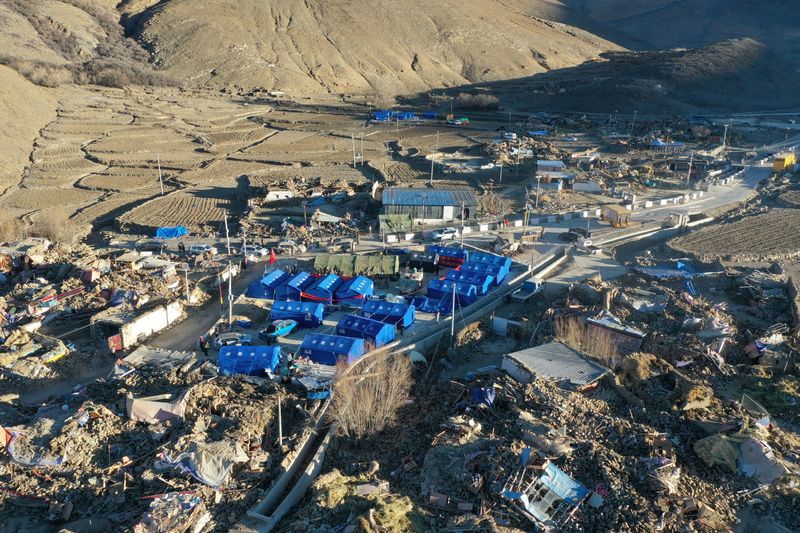
Written by Joe Cash and Ryan Wu
BEIJING (Reuters) – Authorities moved more than 45,000 people in quake-hit Tibet to shelters in a massive rescue operation near the foot of the Himalayas, ending a search in a high-altitude environment where the chances of survival were always slim. .
The epicenter of Tuesday's 6.8-magnitude earthquake, one of the strongest tremors the Chinese region has witnessed in recent years, was in Tengri, a rural county with a population of about 60,000 located about 80 kilometers north of Mount Everest.
The quake shook buildings as far away as Nepal and parts of India, destroying more than 3,600 homes around Tingri, presenting a massive task for rescuers in an area with an average elevation of more than 4,000 meters (13,000 feet).
Forty-eight hours after the quake, experts say those trapped under the rubble likely succumbed to hypothermia, with temperatures dropping to minus 18 degrees Celsius (0 degrees Fahrenheit) at night.
A preliminary toll on Tuesday evening showed that at least 126 people were killed and 188 injured, according to Chinese official media. It remained unchanged until Thursday.
The Xinhua News Agency reported that rescue operations focused on 27 villages within a 20-kilometre radius of Tingri. The area is home to 7,000 people.
Chinese officials on Wednesday ended the search for survivors, saying the focus had shifted to transporting the displaced and treating the wounded after 407 people were pulled from the rubble.
The authorities have not yet determined how many people are still missing.
The State Council Information Office, which handles media inquiries on behalf of the central government, did not respond to a Reuters request for comment.
Foreign journalists need official permission to enter Tibet, which has been under Chinese rule since a failed uprising in 1959.
The Dalai Lama, who lives in exile in India, said he was deeply saddened by the earthquake and would pray for the victims.
Beijing has described him as a “separatist.”
“Under the strong leadership of the Communist Party of China Central Committee, people in disaster areas will definitely be able to overcome the disaster and rebuild their homes,” a Chinese Foreign Ministry spokesman said on Wednesday.
“We are well aware of the Dalai Lama's divisive nature and political designs, and we remain on high alert,” he added.
State media said on Thursday, citing the Chinese Earthquake Networks Center, that the earthquake came as a result of the pressure of the Indian plate towards the north. The plate, which collided with the Eurasian plate about 50 million years ago, continues to move 5 cm (1.97 inches) northeast each year.
Tuesday's quake was so strong, that part of the terrain surrounding the epicenter dropped as much as 1.6 meters (5 feet 3 inches) over a distance of 80 kilometers (50 miles), according to a USGS analysis.
Reconstruction
Gyaltsen Norbu, the Panchen Lama and second only to the Dalai Lama in spiritual authority, chanted prayers with about 900 monks on Wednesday at Tashilhunpo Monastery in Shigatse, Xinhua News Agency reported.
Norbu, who was identified by Beijing in 1995 as the 11th Panchen Lama but not recognized by the Dalai Lama, also made a donation to earthquake relief efforts, Xinhua reported.
China's response after the disaster was rapid, with 11,000 rescuers deployed to the earthquake area within hours of the first tremors. There were more than 1,000 aftershocks.
Zhang Guoping, Vice Premier of the State Council, led the earthquake relief efforts by visiting the worst-hit areas.
Xinhua quoted Zhang as saying on Wednesday that the reconstruction process must be accelerated to ensure that the displaced can move to safe and warm homes as quickly as possible.
State media said that about 46,500 people affected by the earthquake were transferred to 187 resettlement sites in towns surrounding the epicenter in Tingri.
CCTV reported that rescue personnel began constructing prefabricated homes to replace the tents of the displaced. About 1,000 earthquake-resistant and heated houses have been sent to Tingri and can be erected in about 10 minutes.

The last similar earthquake to hit the region was in November 2017 when a 6.9 magnitude earthquake struck Minling in the east, the strongest earthquake to hit southern Tibet since 1950.
The Mainling earthquake triggered more than 300 aftershocks, affecting more than 12,000 people and damaging about 3,000 homes. Three people were injured.







